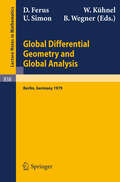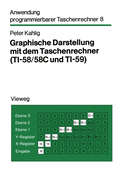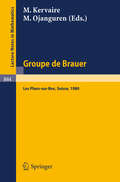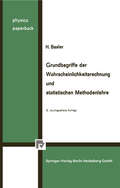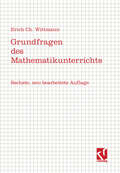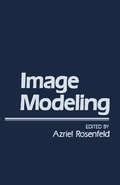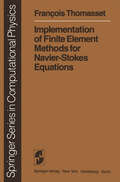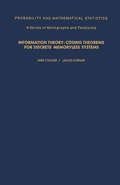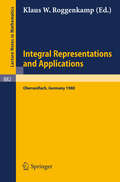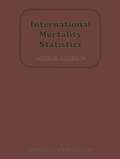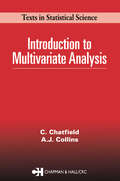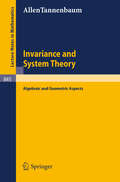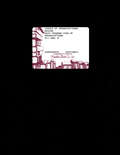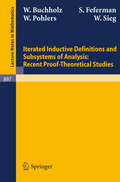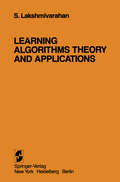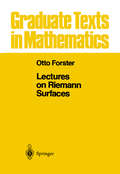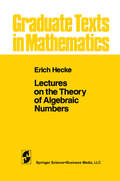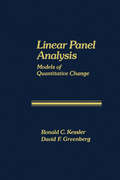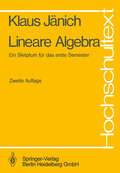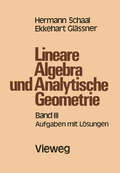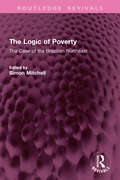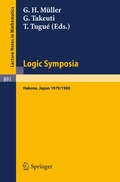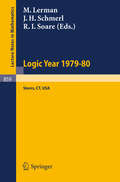- Table View
- List View
Global Differential Geometry and Global Analysis: Proceedings of the Colloquium Held at the Technical University of Berlin, November 21-24, 1979 (Lecture Notes in Mathematics #838)
by D. Ferus W. Kühnel U. Simon B. WegnerGraphische Darstellung mit dem Taschenrechner: TI-58/58C und TI-59 (Anwendung programmierbarer Taschenrechner #8)
by Peter KahligGroupe de Brauer: Seminaire, Les Plans-sur-Bex, Suisse, 1980 (Lecture Notes in Mathematics #844)
by M. Kervaire M. OjangurenGrundbegriffe der Wahrscheinlichkeitsrechnung und statistischen Methodenlehre
by H. Baslerten Beispiele und Aufgaben überpriift. Dem Verleger, Herrn Liebing, danke ich ftir sein bis in sachliche Einzelheiten gehendes Interesse, das er dem Entstehen dieses Buches entgegengebracht hat. Würzburg, im April 1968 Herbert Basler Vorwort zur 7. Auflage Das Konzept des Buches war und ist, ftir Nicht-Mathematiker eine mathematisch saubere, aber soweit wie möglich von mathematischer Technik entlastete Einftih rung in die Wahrscheinlichkeitsrechnung und angewandte Mathematische Statistik zu bieten. Während der vorangegangenen Auflagen habe ich bemerkt, daf~ auch bei Mathematikern ein Bedürfnis nach einer solchen Einflihrung als einer Propädeutik ftir einschlägige rein mathematische Kurse besteht. Insbesondere diese Bindeglied Funktion zwischen mathematischer Theorie und Anwendungen habe ich in der vor liegenden Auflage weiter auszubauen versucht, da ich beispielsweise beobachte, daß es Mathematik-Studenten, die an Kursen ftir Nicht-Mathematiker teilnehmen, oft nicht mehr möglich ist, die vermeintliche Kluft zwischen so einer Statistischen Me thodenlehre und einer maßtheoretisch fundierten Wahrscheinlichkeitstheorie und Mathematischen Statistik zu überbrücken und den Zusammenhang zu sehen. In die se Richtung gehen die Erweiterungen am Schluß von 1. 4. 3 (S. 48), am Schluß von 2. 1 (Charakterisierungssatz ftir Verteilungsfunktionen, S. 65f. ), im neuen Abschnitt 2. 2. 1 (Verwendung des Terminus "Grundgesamtheit", S. 73f. ) sowie der Abschnitt 3. 1 Stichproben. Dabei habe ich vielfach Kleindruck verwendet um "stärker vor wärts drängenden Lesern" die Möglichkeit zu geben. den Faden zu behalten, wenn sie solche Passagen übergehen wollen. Außerdem habe ich viele Teile neu formuliert, so z. B.
Image Modeling
by Azriel RosenfeldImage Modeling compiles papers presented at a workshop on image modeling in Rosemont, Illinois on August 6-7, 1979.This book discusses the mosaic models for textures, image segmentation as an estimation problem, and comparative analysis of line-drawing modeling schemes. The statistical models for the image restoration problem, use of Markov random fields as models of texture, and mathematical models of graphics are also elaborated. This text likewise covers the univariate and multivariate random field models for images, stochastic image models generated by random tessellations of the plane, and long crested wave models. Other topics include the Boolean model and random sets, structural basis for image description, and structure in co-occurrence matrices for texture analysis.This publication is useful to specialists and professionals working in the field of image processing.
Implementation of Finite Element Methods for Navier-Stokes Equations (Scientific Computation)
by F. ThomassetIn structure mechanics analysis, finite element methods are now well estab lished and well documented techniques; their advantage lies in a higher flexibility, in particular for: (i) The representation of arbitrary complicated boundaries; (ii) Systematic rules for the developments of stable numerical schemes ap proximating mathematically wellposed problems, with various types of boundary conditions. On the other hand, compared to finite difference methods, this flexibility is paid by: an increased programming complexity; additional storage require ment. The application of finite element methods to fluid mechanics has been lagging behind and is relatively recent for several types of reasons: (i) Historical reasons: the early methods were invented by engineers for the analysis of torsion, flexion deformation of bearns, plates, shells, etc ... (see the historics in Strang and Fix (1972) or Zienckiewicz (1977». (ii) Technical reasons: fluid flow problems present specific difficulties: strong gradients,l of the velocity or temperature for instance, may occur which a finite mesh is unable to properly represent; a remedy lies in the various upwind finite element schemes which recently turned up, and which are reviewed in chapter 2 (yet their effect is just as controversial as in finite differences). Next, waves can propagate (e.g. in ocean dynamics with shallowwaters equations) which will be falsely distorted by a finite non regular mesh, as Kreiss (1979) pointed out. We are concerned in this course with the approximation of incompressible, viscous, Newtonian fluids, i.e. governed by N avier Stokes equations.
Information Theory: Coding Theorems for Discrete Memoryless Systems
by Imre Csiszár János KörnerInformation Theory: Coding Theorems for Discrete Memoryless Systems presents mathematical models that involve independent random variables with finite range. This three-chapter text specifically describes the characteristic phenomena of information theory. Chapter 1 deals with information measures in simple coding problems, with emphasis on some formal properties of Shannon’s information and the non-block source coding. Chapter 2 describes the properties and practical aspects of the two-terminal systems. This chapter also examines the noisy channel coding problem, the computation of channel capacity, and the arbitrarily varying channels. Chapter 3 looks into the theory and practicality of multi-terminal systems.This book is intended primarily for graduate students and research workers in mathematics, electrical engineering, and computer science.
Integral Representations and Applications: Proceedings of a Conference held at Oberwolfach, Germany, June 22-28, 1980 (Lecture Notes in Mathematics #882)
by Klaus W. RoggenkampIntroduction to Multivariate Analysis
by Chris ChatfieldThis book provides an introduction to the analysis of multivariate data.It describes multivariate probability distributions, the preliminary analysisof a large -scale set of data, princ iple component and factor analysis,traditional normal theory material, as well as multidimensional scaling andcluster analysis.Introduction to Multivariate Analysis provides a reasonable blend oftheory and practice. Enough theory is given to introduce the concepts andto make the topics mathematically interesting. In addition the authors discussthe use (and misuse) of the techniques in pra ctice and present appropriatereal-life examples from a variety of areas includ ing agricultural research,soc iology and crim inology. The book should be suitable both for researchworkers and as a text for students taking a course on multivariate analysis.
Introduction to Multivariate Analysis
by Chris ChatfieldThis book provides an introduction to the analysis of multivariate data.It describes multivariate probability distributions, the preliminary analysisof a large -scale set of data, princ iple component and factor analysis,traditional normal theory material, as well as multidimensional scaling andcluster analysis.Introduction to Multivariate Analysis provides a reasonable blend oftheory and practice. Enough theory is given to introduce the concepts andto make the topics mathematically interesting. In addition the authors discussthe use (and misuse) of the techniques in pra ctice and present appropriatereal-life examples from a variety of areas includ ing agricultural research,soc iology and crim inology. The book should be suitable both for researchworkers and as a text for students taking a course on multivariate analysis.
Invariance and System Theory: Algebraic and Geometric Aspects (Lecture Notes in Mathematics #845)
by Allen TannenbaumIssues of Organizational Design: A Mathematical Programming View of Organizations
by Børge ObelIssues of Organizational Design: A Mathematical Programming View of Organizations analyzes the view that organizations can be represented satisfactorily by a mathematical programming model and relates it to other theories of organizational behavior. The potential of this approach to organizational analysis is evaluated.Comprised of seven chapters, this book begins with an overview of the three major schools of organizational theory: the classical/structural school, the human relations school, and the contingency school. It then defines what an organization is and outlines the relationship between organizational elements. The example of the two-product firm is used to illustrate the basic model framework, and how coordination, diversification, and incentives can be treated in this framework.Subsequent chapters explore the relationship between the contingency approach and the mathematical programming approach to organizational design; the coordination problem and the process of decision making in a decentralized organization; the decomposition of the organization into a number of smaller units; and types of evaluation and incentive schemes for addressing cheating in a multi-level organization. The book also presents a series of empirical studies where a mathematical programming view of organizations has been assumed before concluding with a discussion on the process of designing organizations.This monograph will be useful for students of organizational design and for practitioners who use models in connection with decision making.
Iterated Inductive Definitions and Subsystems of Analysis: Recent Proof-Theoretical Studies (Lecture Notes in Mathematics #897)
by W. Buchholz S. Feferman W. Pohlers W. SiegLearning Algorithms Theory and Applications: Theory and Applications
by S. LakshmivarahanLearning constitutes one of the most important phase of the whole psychological processes and it is essential in many ways for the occurrence of necessary changes in the behavior of adjusting organisms. In a broad sense influence of prior behavior and its consequence upon subsequent behavior is usually accepted as a definition of learning. Till recently learning was regarded as the prerogative of living beings. But in the past few decades there have been attempts to construct learning machines or systems with considerable success. This book deals with a powerful class of learning algorithms that have been developed over the past two decades in the context of learning systems modelled by finite state probabilistic automaton. These algorithms are very simple iterative schemes. Mathematically these algorithms define two distinct classes of Markov processes with unit simplex (of suitable dimension) as its state space. The basic problem of learning is viewed as one of finding conditions on the algorithm such that the associated Markov process has prespecified asymptotic behavior. As a prerequisite a first course in analysis and stochastic processes would be an adequate preparation to pursue the development in various chapters.
Lectures on Riemann Surfaces (Graduate Texts in Mathematics #81)
by Otto ForsterThis book grew out of lectures on Riemann surfaces given by Otto Forster at the universities of Munich, Regensburg, and Münster. It provides a concise modern introduction to this rewarding subject, as well as presenting methods used in the study of complex manifolds in the special case of complex dimension one. From the reviews: "This book deserves very serious consideration as a text for anyone contemplating giving a course on Riemann surfaces."—-MATHEMATICAL REVIEWS
Lectures on the Theory of Algebraic Numbers (Graduate Texts in Mathematics #77)
by E. T. Hecke. . . if one wants to make progress in mathematics one should study the masters not the pupils. N. H. Abel Heeke was certainly one of the masters, and in fact, the study of Heeke L series and Heeke operators has permanently embedded his name in the fabric of number theory. It is a rare occurrence when a master writes a basic book, and Heeke's Lectures on the Theory of Algebraic Numbers has become a classic. To quote another master, Andre Weil: "To improve upon Heeke, in a treatment along classical lines of the theory of algebraic numbers, would be a futile and impossible task. " We have tried to remain as close as possible to the original text in pre serving Heeke's rich, informal style of exposition. In a very few instances we have substituted modern terminology for Heeke's, e. g. , "torsion free group" for "pure group. " One problem for a student is the lack of exercises in the book. However, given the large number of texts available in algebraic number theory, this is not a serious drawback. In particular we recommend Number Fields by D. A. Marcus (Springer-Verlag) as a particularly rich source. We would like to thank James M. Vaughn Jr. and the Vaughn Foundation Fund for their encouragement and generous support of Jay R. Goldman without which this translation would never have appeared. Minneapolis George U. Brauer July 1981 Jay R.
The Logic of Poverty: The Case of the Brazilian Northeast (Routledge Revivals)
First published in 1981, The Logic of Poverty consists of eight essays that share at least one assumption: that Northeast Brazil provides a startling example of inhumane economic development. The contributors have all worked in the area, and know it at first hand. They look at rural structure and the role of the unemployed ‘reserve army’, the state of the sugar industry, the ineffectiveness of the irrigation schemes, the stagnation in the fishing sector, the lack of credit available to peasants and the role of SUDENE, the first development agency in the region. Together they paint a picture of poverty and of the factors that allow it to continue, and they place that poverty in the context of the wider economy of Brazil, relating it to the extraordinary transformation that has been called ‘the Brazilian miracle’. This book will be of interest to students of geography, anthropology, economics and sociology.
The Logic of Poverty: The Case of the Brazilian Northeast (Routledge Revivals)
by Simon MitchellFirst published in 1981, The Logic of Poverty consists of eight essays that share at least one assumption: that Northeast Brazil provides a startling example of inhumane economic development. The contributors have all worked in the area, and know it at first hand. They look at rural structure and the role of the unemployed ‘reserve army’, the state of the sugar industry, the ineffectiveness of the irrigation schemes, the stagnation in the fishing sector, the lack of credit available to peasants and the role of SUDENE, the first development agency in the region. Together they paint a picture of poverty and of the factors that allow it to continue, and they place that poverty in the context of the wider economy of Brazil, relating it to the extraordinary transformation that has been called ‘the Brazilian miracle’. This book will be of interest to students of geography, anthropology, economics and sociology.
